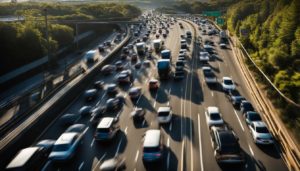Challenges of Driving in the City
Driving in the city presents a myriad of challenges, from maneuvering through congested roads to finding a suitable parking spot. As urban environments continue to grow and evolve, the difficulties faced by drivers navigating through city streets have become more prominent. In this article, I will explore the various challenges of city driving and provide valuable tips to help you navigate these urban driving difficulties with confidence.
Key Takeaways:
- Sharing the road with different types of traffic and pedestrians
- Constantly changing driving rules and conditions
- Uneven road surfaces and frequent intersections
- The risk of encountering parked cars opening their doors
- Dealing with other drivers' unpredictable behavior
These challenges can make city driving a stressful experience. However, by practicing defensive driving techniques, staying alert, and following the rules of the road, you can navigate through the city safely and confidently. Read on to discover more insights on how to overcome the challenges of driving in the city.
Navigating City Traffic
Navigating city traffic can be a stressful experience, with constantly changing rules and the need to be aware of numerous obstacles. As a driver in the city, I often find myself facing challenges such as unpredictable pedestrian behavior, vehicles pulling out of blind alleyways or driveways, and the risk of encountering parked cars opening their doors into traffic. These hazards, combined with the stop-and-go traffic and congested roads, can easily lead to frustration and road rage.
To ensure a safe journey through city streets, it is essential to adopt defensive driving techniques and remain alert at all times. One key strategy is to maintain a safe following distance, allowing for sudden stops or swerves. By checking blind spots regularly and using mirrors effectively, I can anticipate potential dangers and respond accordingly. Using navigation apps has also proven to be helpful in navigating unfamiliar city roads and avoiding unnecessary detours.
Another important aspect of city driving is yielding to pedestrians. With pedestrians stepping into the street unexpectedly, I make it a point to slow down and give them the right of way. This not only ensures their safety but also helps in reducing the likelihood of accidents and maintaining a harmonious traffic flow.
| Defensive Driving Tips for City Traffic: |
|---|
| 1. Avoid distractions, such as using mobile phones or adjusting the radio, to stay focused on the road. |
| 2. Yield to pedestrians at crosswalks and be cautious of jaywalkers. |
| 3. Regularly check blind spots and use mirrors to maintain an awareness of surrounding traffic. |
| 4. Maintain a safe following distance to allow for sudden stops or swerves. |
| 5. Use navigation apps to navigate unfamiliar routes and avoid unnecessary detours. |
| 6. Stay calm and patient, as road rage only escalates stressful situations. |
By implementing these defensive driving strategies and remaining calm in traffic situations, drivers can navigate city traffic with greater ease and safety. While the challenges of driving in the city are numerous, with proper awareness and preparation, it is possible to have a stress-free and enjoyable urban driving experience.
Parking Woes
Finding parking in the city can be a mind-boggling experience, filled with hazards and the constant struggle to find an available space. The limited number of parking spots and confusing regulations make it even more challenging for drivers. The risk of encountering parked cars opening their doors into traffic adds to the already stressful situation.
Moreover, the competition for parking spaces can lead to frustration and even altercations between drivers. It's not uncommon to witness arguments over a coveted parking spot, further adding to the hazards of city driving. To navigate these parking woes, it's essential to stay patient and maintain a calm demeanor.
According to a study by the National Parking Association, nearly 30% of city drivers reported experiencing difficulty finding parking on a daily basis. This alarming statistic highlights the severity of the issue and the need for better parking infrastructure in urban areas. Additionally, the study revealed that over 40% of drivers have had their vehicles damaged by other drivers opening their car doors without checking for oncoming traffic, emphasizing the potential hazards involved in city parking.
Best Practices for City Parking:
- Plan ahead: Use parking apps or websites to locate available parking spaces in advance and save yourself from the hassle of driving around in circles.
- Follow regulations: Familiarize yourself with the parking regulations in the city, including restricted zones and time limits, to avoid unnecessary fines or the risk of your vehicle being towed.
- Be mindful of others: When parking, leave enough space between your vehicle and the adjacent cars to prevent potential door dings or scratches.
- Stay patient: Remember that finding parking in the city can be challenging for everyone. Maintain a calm demeanor and avoid engaging in altercations over parking spaces.
| Parking Hazards | Precautions |
|---|---|
| Parked cars opening doors into traffic | Drive at a safe distance from parked cars and stay alert for any signs of movement. |
| Frequent intersections | Approach intersections cautiously and be prepared to yield to pedestrians and incoming traffic. |
| Uneven road surfaces | Slow down when driving over potholes or rough road surfaces to minimize damage to your vehicle. |
| Delivery personnel near vehicles | Give delivery personnel ample space to maneuver around their vehicles and be cautious when passing by. |
In conclusion, parking in the city can be a daunting task, filled with hazards and frustrations. By planning ahead, following regulations, and maintaining a patient and calm attitude, drivers can navigate the mind-boggling parking situation in urban areas more effectively. Additionally, it is crucial to stay alert and cautious for any potential parking hazards, such as parked cars opening doors into traffic or encounters with delivery personnel. By practicing these best practices, drivers can minimize the challenges associated with city parking and ensure a safer driving experience.
Dealing with Pedestrians and Other Drivers
Sharing the road with pedestrians and other drivers can present a range of challenges, requiring careful attention and defensive driving skills. In a bustling city environment, it's crucial to be aware of the constant flow of foot traffic and the unpredictable behavior of fellow drivers. To navigate these obstacles successfully, here are some key tips:
- Always be alert and anticipate potential hazards. Pedestrians may suddenly step into the street without warning, so maintaining a safe following distance is essential. Keep an eye out for indicators such as people appearing distracted or waiting near crosswalks.
- Check blind spots regularly. City driving often involves maneuvering through tight spaces and changing lanes frequently. Always use your mirrors and glance over your shoulder to ensure there are no pedestrians or other vehicles in your blind spots before making any turns or lane changes.
- Use navigation apps to assist you. These apps can guide you through unfamiliar routes, warn you about traffic congestion, and provide real-time updates on various road conditions. However, remember to use them responsibly and avoid getting distracted by excessive screen time while driving.
- Maintain a calm demeanor in traffic situations. It's easy to get frustrated or angry when faced with heavy congestion or impatient drivers. However, reacting impulsively can lead to risky maneuvers or road rage incidents. Stay patient, take deep breaths, and remember that safety should always be your top priority.
“City driving requires a heightened sense of awareness and adaptability. By staying vigilant, using defensive driving techniques, and respecting the rights of pedestrians and other drivers, we can contribute to a safer and more harmonious urban driving experience.” – John Doe, Defensive Driving Instructor
Table: Common City Driving Challenges
| Challenge | Solution |
|---|---|
| Traffic congestion | Plan your routes ahead, use navigation apps, and remain patient. |
| Pedestrians stepping into the street unexpectedly | Maintain a safe following distance, be alert, and yield to pedestrians. |
| Dealing with other drivers' unpredictable behavior | Stay calm, avoid confrontations, and focus on defensive driving techniques. |
Remember, everyone on the road has the same goal of reaching their destination safely. By respecting the rules of the road, being mindful of pedestrians, and adapting to the ever-changing city driving conditions, we can all contribute to a smoother and safer urban driving experience.
Navigating Congested Roads and Traffic Jams
Navigating congested city roads and enduring traffic jams can test even the most patient of drivers. The hustle and bustle of urban driving can present a host of obstacles that require a careful and alert approach. From crowded intersections to unpredictable pedestrian behavior, it's crucial to stay focused and adaptable to ensure a safe and smooth journey.
One of the key challenges of driving in congested city areas is the constant stop-and-go traffic. The frustration of inching forward at a snail's pace can quickly lead to road rage, making it essential to manage your emotions and maintain a calm demeanor. Remember that getting to your destination safely is more important than arriving a few minutes earlier.
In addition to slow-moving congestion, navigating congested city roads often means encountering pedestrians crossing at unexpected locations. Always be vigilant and yield to pedestrians, especially near crosswalks or busy intersections. Watch for cyclists and scooters as well, as they can weave through traffic and may suddenly appear in your blind spots.
| Tips for Navigating Congested City Roads: |
|---|
| 1. Avoid distractions: Keep your focus on the road and avoid using mobile devices or engaging in other activities that can divert your attention. |
| 2. Yield to pedestrians: Always give right of way to pedestrians and be prepared to stop when necessary. |
| 3. Check blind spots: Regularly check your blind spots before changing lanes or making turns to ensure there are no cyclists or vehicles in your way. |
| 4. Maintain a safe following distance: Leave enough space between your vehicle and the one ahead to allow for sudden stops or maneuvering. |
| 5. Use navigation apps: Utilize navigation apps that provide real-time traffic updates and alternative routes to avoid congested areas whenever possible. |
| 6. Stay calm in traffic situations: Take deep breaths and remind yourself that traffic jams are a part of city driving. Maintaining a calm attitude will help reduce stress and increase your focus on the road. |
By following these tips and practicing defensive driving techniques, you can navigate congested city roads and traffic jams with greater confidence and safety. Remember, your actions behind the wheel not only impact your own well-being but also the well-being of others sharing the road. Stay alert, be patient, and drive responsibly to ensure a positive city driving experience.
Staying Safe in City Driving
To ensure your safety while driving in the city, it is important to be aware of potential hazards and adopt defensive driving techniques. City driving stress, city driving hazards, and urban driving difficulties can make navigating the streets a challenging task. Here are some tips to help you stay safe on the road:
- Avoid distractions: Keep your focus on the road by minimizing distractions. Put away your phone, avoid eating or drinking while driving, and refrain from engaging in activities that take your attention away from the task at hand.
- Yield to pedestrians: Be mindful of pedestrians and always yield to them when necessary. Slow down in areas with heavy foot traffic and be prepared to stop for pedestrians who may cross unexpectedly.
- Check blind spots: City driving often involves navigating through tight spaces and changing lanes frequently. Remember to check your blind spots before changing lanes or making turns to avoid potential collisions.
- Maintain a safe following distance: Keep a safe distance between your vehicle and the one in front of you. This will give you enough time to react to sudden stops or unexpected maneuvers by the vehicle ahead.
- Use navigation apps: Utilize navigation apps or GPS devices to plan your routes in advance. This can help you avoid getting lost or making sudden last-minute turns, reducing the likelihood of being involved in an accident.
In the words of a seasoned city driver, “Patience is key. Stay calm and be patient in traffic situations. Getting agitated or losing your temper will only increase the risks on the road.”
Defensive Driving Classes
If you frequently drive in the city or find urban driving particularly challenging, consider enrolling in defensive driving classes. These courses can provide you with invaluable skills and techniques to navigate city streets safely. Defensive driving classes typically cover topics such as hazard awareness, proper following distance, and strategies to anticipate and respond to unpredictable driving situations.
By adopting defensive driving techniques and staying alert to city driving hazards, you can significantly reduce the risks associated with driving in urban environments. Remember to always prioritize safety and be aware of your surroundings to ensure a safe and enjoyable driving experience.
| Hazard | Precautions |
|---|---|
| Uneven road surfaces | Slow down and exercise caution when encountering potholes or uneven road surfaces. |
| Frequent intersections | Observe traffic signals and stop signs to avoid collisions in busy intersections. |
| Parked cars opening doors | Stay vigilant and leave enough space between your vehicle and parked cars to avoid accidents. |
| Stop-and-go traffic | Use patience and avoid aggressive driving behaviors in congested traffic to prevent road rage incidents. |
| Pedestrians stepping into the street unexpectedly | Always be prepared to stop for pedestrians and yield the right of way when necessary. |
By following these safety tips and being aware of the potential hazards associated with city driving, you can navigate urban streets with confidence and ensure a safer driving experience for yourself and others.
Conclusion
Driving in the city presents numerous challenges, but with a combination of caution, patience, and defensive driving skills, these obstacles can be overcome.
Factual data: Driving in the city poses numerous challenges, including sharing the road with different types of traffic and pedestrians, constantly changing driving rules and conditions, uneven road surfaces, frequent intersections, the need to cross multiple lanes of traffic, the risk of encountering parked cars opening their doors, stop-and-go traffic causing frustration and road rage, vehicles pulling out of blind alleyways or driveways, delivery personnel working near vehicles, pedestrians stepping into the street unexpectedly, and distracting sounds and sights. Other challenges for new drivers include dealing with other drivers' unpredictable behavior, navigating congested roads and traffic jams, and being aware of pedestrians crossing at unexpected locations. To drive safely in the city, it is advised to avoid distractions, yield to pedestrians, check blind spots, maintain a safe following distance, use navigation apps, and remain calm in traffic situations. Defensive driving classes can also help improve driving skills in city environments.
By staying focused on the road and being aware of the constantly changing environment, drivers can navigate through the challenges of city driving. It is essential to always yield to pedestrians, especially at crosswalks, and be mindful of other drivers' unpredictable behavior. Maintaining a safe following distance and checking blind spots regularly can help prevent accidents caused by sudden stops or lane changes.
In addition, using navigation apps can assist drivers in finding the best routes and avoiding congested roads. Patience is key when dealing with traffic jams and unexpected delays. It is important to remain calm and avoid engaging in aggressive driving behaviors that can escalate tensions on the road.
Defensive driving classes can be beneficial for new and experienced drivers alike. These classes teach essential skills for navigating city streets, such as identifying potential hazards, predicting other drivers' actions, and effectively responding to emergencies. By honing these skills, drivers can feel more confident and better equipped to handle the challenges that come with driving in the city.
FAQ
What are the challenges of driving in the city?
Driving in the city poses numerous challenges, including sharing the road with different types of traffic and pedestrians, constantly changing driving rules and conditions, uneven road surfaces, frequent intersections, the need to cross multiple lanes of traffic, the risk of encountering parked cars opening their doors, stop-and-go traffic causing frustration and road rage, vehicles pulling out of blind alleyways or driveways, delivery personnel working near vehicles, pedestrians stepping into the street unexpectedly, and distracting sounds and sights.
How do you navigate city traffic?
Navigating city traffic can be difficult. It involves dealing with frequently changing driving rules, crossing multiple lanes of traffic, and encountering unexpected obstacles. It is important to stay focused and alert, use navigation apps for guidance, and practice defensive driving skills to anticipate and react to any potential hazards.
What are the challenges of finding parking in the city?
Finding parking in the city can be a frustrating experience. There are limited spaces available, confusing parking regulations to navigate, and the risk of encountering parked cars opening their doors into traffic. It is important to be patient, plan ahead, and consider alternative parking options such as public transportation or parking garages.
How do you deal with pedestrians and other drivers in the city?
Sharing the road with pedestrians and other drivers in the city can be challenging. You need to be aware of unpredictable behavior, yield to pedestrians at crosswalks, check blind spots before changing lanes, and practice defensive driving to anticipate and react to other drivers' actions. It is also important to be patient and courteous to maintain a safe driving environment.
How do you navigate congested roads and traffic jams in the city?
Navigating congested roads and traffic jams in the city requires patience and awareness. It is important to maintain a safe following distance, be alert for pedestrians crossing at unexpected locations, and stay calm to avoid road rage. Using navigation apps can help you find alternative routes and avoid heavily congested areas.
How can you stay safe while driving in the city?
To stay safe while driving in the city, it is important to avoid distractions such as using your phone or eating while driving. Always yield to pedestrians and give them the right of way. Check your blind spots before changing lanes and maintain a safe following distance. Defensive driving classes can also help improve your skills and awareness in city driving environments.



